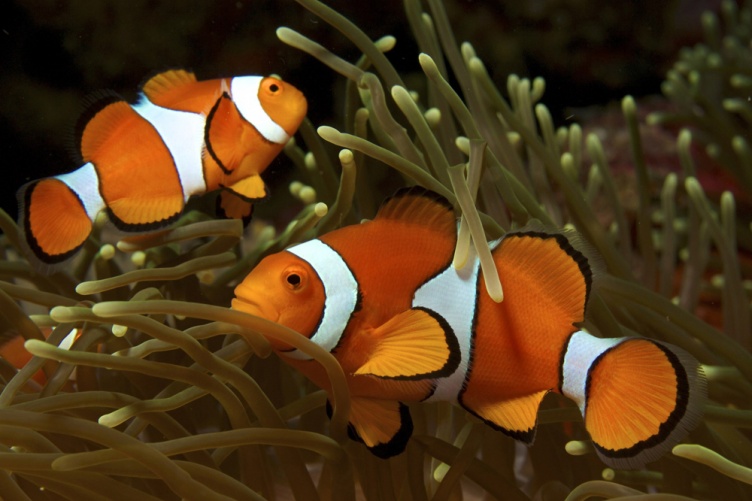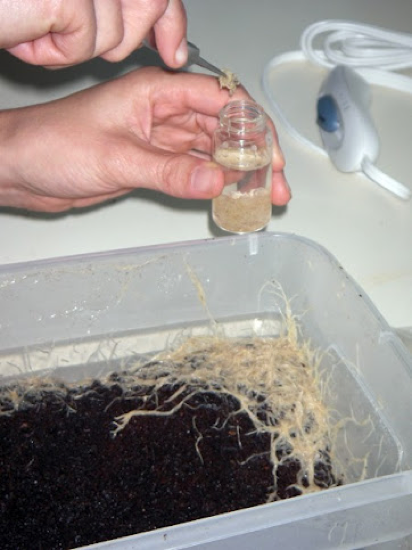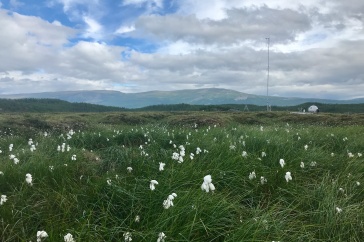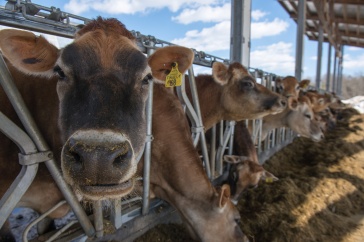
Ornamental aquarium fish like the clownfish one day may be dining on high-quality yet inexpensive white worms grown in New England. Credit: Nick Hobgood
Ornamental aquarium fish like the clownfish Nemo and his pal the royal blue tang Dory one day may be dining on high-quality yet inexpensive white worms grown in New England. New research from the New Hampshire Agricultural Experiment Station at the University of New Hampshire has found that live white worms are well-suited for the ornamental aquaculture industry and could be an emerging commercial industry for the region.
Experiment station researcher Elizabeth Fairchild, research associate professor of biological sciences, studies the commercial viability of white worms for aquaculture. White worms (Enchytraeus albidus) are small worms that are easily grown in terrestrial systems but can survive in both fresh and full-strength seawater. They wriggle and attract predators, and do not impair water quality when added to aquaculture systems, making them ideal live feeds for cultured aquatic species.

Fairchild's experiment station-funded research aims to develop “modern” white worm agricultural procedures. Historically white worms were used with great success to feed farmed sturgeon fry in the former U.S.S.R., but today commercial scale production no longer exists. She said updating white worm production using 21st century techniques could lead to commercial scale production to produce food for numerous farmed aquatic species.
“White worms show great promise as a live feed for a diverse set of cultured organisms during some period of their development, including freshwater and marine fishes, as well as for some crustaceans, amphibians, reptiles, and birds. In particular, there is high interest from all sectors of the aquaculture industry to utilize new feed sources, including white worms, as more and more aquatic species are being cultivated,” Fairchild said.
UNH researchers conducted experiments to evaluate how low- or no-cost byproducts affected white worm production and nutrition, and if adding enrichments changed the fatty acid profile of the worms, making them a more nutritious feed. They evaluated if live white worms harbored diseases, which would put aquaculture facilities at risk. They distributed almost 250,000 white worms to facilities in the United States in exchange for feedback on their experiences using the worms.
“Based on stakeholder input, the interest showed by most ornamental fishes the worms were offered to, we think the best potential for using white worms is as a diet for ornamental fishes,” Fairchild said.
Ornamental culture is a growing sector in the aquaculture industry, valued at close to $30 million in Florida alone in 2012, which helps supply organisms to the 700,000 private aquaria in the United States. While protocols have been established to rear many of the “typical” aquaria fishes like damsels, dottybacks, gobies, and blennies, there is a strong market demand for production of other fishes like tangs, wrasses, and butterflyfish.
“For many of these latter species, feeding regimes have yet to be worked out yet they responded very favorably to live white worms. Judging from our experiences with supplying live white worms to ornamental aquaculturists, white worms may help with expanding the opportunities to culture these trickier species,” Fairchild said.
Specifically, the researchers found white worms are an easily and cheaply cultivated, pathogen-free feed, high in protein and fat, that are readily consumed by many fishes, especially ornamentals.
“These findings are important because in order to increase the U.S. aquaculture industry, and in this case the ornamental industry, we need to be able to provide environmentally friendly and nutritionally appropriate feeds. Figuring out how to culture new species is challenging, and feeding protocols must be figured out. So far, everything we’ve fed white worms to has eaten them, and especially those tricky new species readily consumed the white worms. We think white worms may be very helpful to ornamental aquaculture expansion,” Fairchild said.
While the majority of the ornamental aquaculture industry does not occur in New Hampshire, much less New England, there could be a service provider business opportunity for the Granite State. Fairchild said white worms likely can’t be grown cost-effectively in the South since the worms do not do well in tropical climates, and it would be expensive to air condition a large worm warehouse facility. But the worms grow quite well under New England room temperature environments.
“If we can figure out a cheap way to deliver the product – the white worms – to the clients, then this could result in a new New England industry. Maple syrup is a good analogy: maple syrup can’t be produced in the South – it’s only produced in northern areas like New England and New Hampshire – yet southerners put it on their pancakes too,” she said.
These research results are presented in “Production and nutritional composition of white worms Enchytraeus albidus fed different low-cost feeds” in the journal Aquaculture.
This material is based upon work supported by the NH Agricultural Experiment Station, through joint funding of the National Institute of Food and Agriculture, U.S. Department of Agriculture, under award number 1003418, and the state of New Hampshire. This research also was supported by the Northeastern Regional Aquaculture Center and numerous collaborating scientists, participants, and aquaculture facilities from across the United States that tested white worms or provided feedback.
Founded in 1887, the NH Agricultural Experiment Station at the UNH College of Life Sciences and Agriculture is UNH’s original research center and an elemental component of New Hampshire's land-grant university heritage and mission. We steward federal and state funding, including support from the USDA National Institute of Food and Agriculture, to provide unbiased and objective research concerning diverse aspects of sustainable agriculture and foods, aquaculture, forest management, and related wildlife, natural resources and rural community topics. We maintain the Woodman and Kingman agronomy and horticultural research farms, the Macfarlane Research Greenhouses, the Fairchild Dairy Teaching and Research Center, and the Organic Dairy Research Farm. Additional properties also provide forage, forests and woodlands in direct support to research, teaching, and outreach.
-
Written By:
Lori Tyler Gula, PhD | NH Agricultural Experiment Station | lori.gula@unh.edu | 603-862-1452



















































